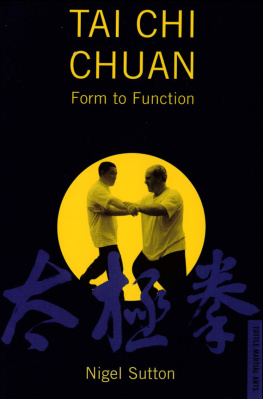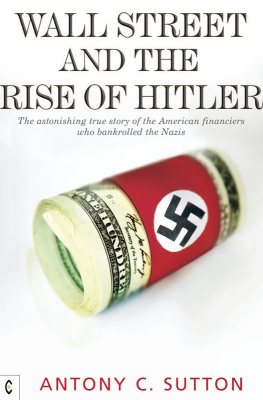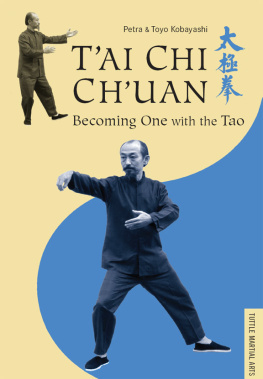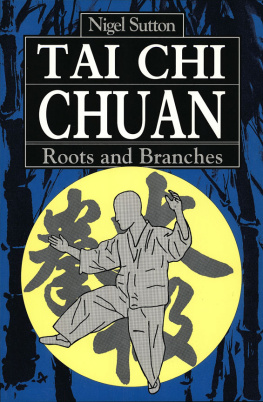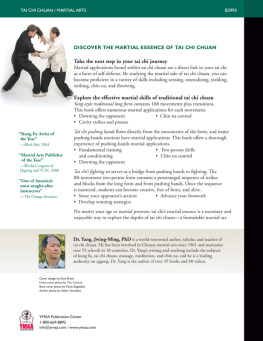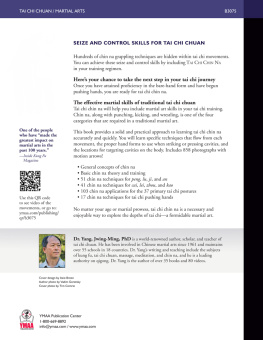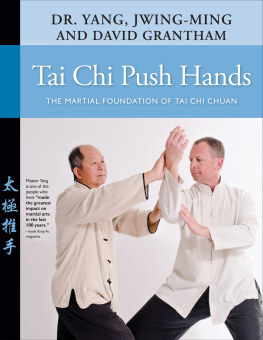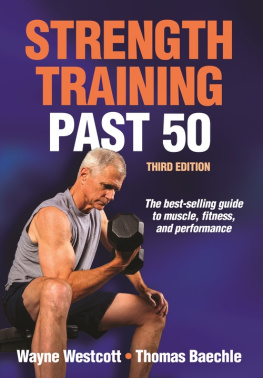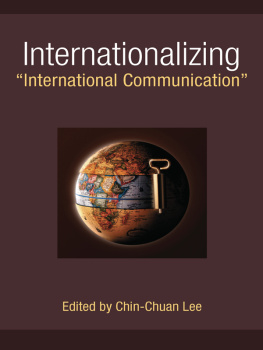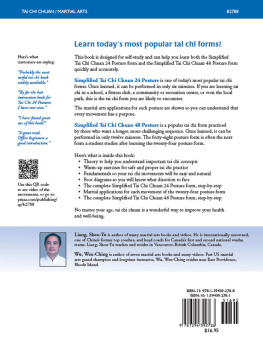CHAPTER ONE
SINGLE-HAND PATTERNS
The following patterns involve the use of just single-hand contact with your partner; The other hand, however, must not be allowed to "die." Just as in forms practice, you are "aware" of the apparently inactive hand. This awareness has the effect of balancing the body and prevents you from becoming fixated on the point of contact with your partner.
Warmup Exercises
Before embarking on pushing hands practice, it is important that you warm up properly. A general warmup might include the performance of several sets of tai chi form. Then complete the following solo and partner exercises:
Solo Warmup
To begin, stand in a front stance with your arms hanging loosely at your sides.


Rotating around an imaginary line running down through the center of your body, turn from the waist, first left, then right (Figs. 1 & 2). Next, bend forward from the waist, but keep your back as straight as possible (Fig. 3). Then bend back as far as you can while maintaining a straight back (Fig. 4).


Finally bend to the right and then to the left, with your body still facing forward (Fig. 5, 6).
This completes one set. At first, perform the exercise slowly, as a stretch. Then, as the body gets warmer, increase the speed. Repeat for as many sets as necessary.


Partner Warmup
To begin, stand facing your, partner, both in a front stance, both with the right leg forward (afterward, the exercise may be repeated on the left). You should be close enough to each other that your front legs are parallel.
With your right hand, push gently against your partner's left shoulder so that he turns to the left (Photo 1). Repeat with your left hand against your partner's right shoulder (Photo 2).
You should push your partner only as far as he can comfortably go. As you do this, be aware of the position of your hand in relation your partner's body. Your partner should focus his awareness on the part of his body that is being touched. Both partners should attempt to match their force (in this case the light contact between hand and shoulder) and speed so that contact is not lost. (For illustrations see Two-Hand Pattern 5.)
Next you push your partner's right hip with your left hand so that he is forced to "fold" in and turn to the right (Photo 3). Repeat this movement on the other side (Photo 4). The partner being pushed should try not to let his backside stick out, which would result in a loss of balance. Instead, his center of gravity should be kept as close as possible to a position over the "bubbling well" point (yong quan) in the center of the load-bearing foot.




To perform the third part of the exercise, push your partner's left shoulder with your right hand. Again, this moves his body to a diagonal (Photo 5). Next place, your right hand against his stomach and your left hand on the center of his upper back. Your left hand pushes him down over the pivot point of your right hand (Photo 6). Your partner should allow himself to go with this movement, but not so much as to fall to the ground.
Continue the exercise by reversing the position of your hands so that the right hand moves up to your partner's chest while the left hand moves down to the center of his lower back, and push him up. As he rises, use your right hand to push so that he is once again facing you (Photo 7). The complete sequence is then repeated on the left side, and then with the roles reversed so that your partner is pushing and you are being pushed.


Remember to keep your knees bent throughout the exercise and to allow your movements to originate from the waist. This will allow your legs to absorb the momentum of your partner's push. In addition, by using the waist in your own movements, you will ensure that the whole body is working as a unit.

This exercise is important since it not only warms up the whole body but prepares the student for the kind of movement that he will need to know to be effective in freestyle pushing hands practice or competition.
Single-Hand Pattern 1
This exercise provides a very dear introduction to the training of sensitivity. While most of your attention will be focused on your hand and the point where it is touching your partner's hand, you must also take care to keep the other hand alive and make sure that your stance is correct. You will find that your legs very quick by become tired and that it is easy to "cheat" by minimizing your waist movements, but try to avoid doing so. With diligent practice this simple exercise will not only improve your sensitivity but also strengthen your legs and make your waist more flexible.
For the purposes of this exercise, you should make an imaginary division of your hand into three parts.
The first part (Part A) is from the fingertips to the finger joint nearest them. The second part (Part B) is from that same finger joint to the knuckles.
The third part (Part C) is from the knuckles to the wrist.
At some point or other during the exercise, one of these parts will be making contact with your partner's hand.
By narrowing your attention to a very specific part of the hand, you will be better able to develop sensitivity to your partner's movements.
To start the exercise, stand opposite your partner; both of you should have your right leg forward. You should be standing in a front stance with your front foot parallel with your partner's front foot.
Next, to make the start of the exercise easier, your partner should sit back on his rear leg. Now join your right hands together back to back. Part A of your hand should be in contact with part C of your partner's hand at his wrist. Your partner now turns his waist to the right, which brings the whole of part B of his hand into contact with the whole of part B of your hand. You have now reached as far as you can go, and you will have to start sitting back onto your rear leg. As you sit back, your partner starts to shift his weight forward, and part A of his hand starts to come into contact with part C of your hand, until you are sitting back as far as you can. At this point, in order to neutralize your partner's forward movement, you have to turn your waist to the right, which once again brings part B of your hand into contact with part B of your partner's hand.

